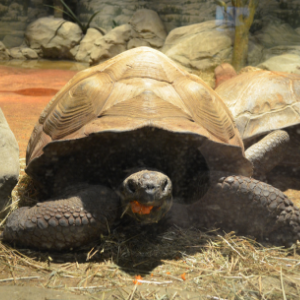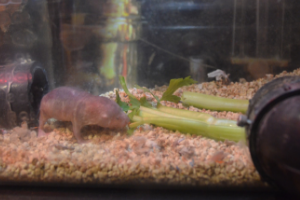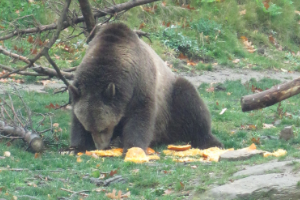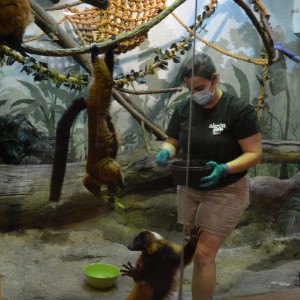It’s summer, and for some of us that means closely monitoring what we eat to support our “beach bodies.” However, diets should be more focused on balance, rather than elimination. Our animals certainly know how to eat well! Here are some food lessons from them:
 1. Veggies can be delicious!
1. Veggies can be delicious!
Our Galapagos tortoises love crunchy veggies! In fact, carrots, celery and lettuce are all a regular part of their diet here at the zoo. In their natural habitat, Galapagos tortoises will eat most types of vegetation, including leaves, grass, bark and cacti. Our tortoises are given a vegetarian diet consisting of more common veggies, like those you might see at the grocery store.
Personally, I would prefer a side of ranch dressing, but there is no better side to bring to a summer picnic than a veggie tray. Your friends will think you are cool as a cucumber!
 2. Don’t be afraid to try new things.
2. Don’t be afraid to try new things.
In March, our naked mole rats tried some celery to celebrate National Celery Month with us! In their natural habitat, naked mole rats eat mostly tubers, like potatoes, since they live underground. Celery is an unusual and exotic food for them. Most did not seem to love it, but a few were willing to give it a try. One of the girls even dragged one of the celery sticks around the habitat with her!
New experiences are valuable, and who knows? You may even find a new favorite food when you are willing to step outside of your comfort zone and try new things!
 3. It’s important to balance your diet, and correspond how much you eat with how active you are!
3. It’s important to balance your diet, and correspond how much you eat with how active you are!
Our grizzly bears have a diet that changes seasonally based on how active they are and what is available in their environment. These omnivores are scavengers, so they eat what they can find. This includes berries, bugs, nuts and greens that are available. At the zoo, our bears enjoy ground meat and fish, as well as leafy greens and veggies.
In the winter, when they are less active, our bears only eat about 3 lbs of food each day. This may seem like a lot, but when they are more active in the summer, each bear may eat up to 15 lbs of food in a day!
 4. Sometimes you can treat yourself to something sweet!
4. Sometimes you can treat yourself to something sweet!
Our lemurs are happy to eat celery as long as it is covered in honey and crasins! In their natural habitat, lemurs are considered opportunistic omnivores: they eat pretty much anything. That means they enjoy a good veggie, but they have also been known to eat dirt, sap, bugs, and even spider webs. Yuck! I would stick to the honey, but maybe that’s just me!
Animal diets are an important part of zoo life. Just like it is important for you to eat meals with balanced nutrition, our animals need to maintain certain diets to stay healthy. These diets are different for each species.
“Native species that are found here at the zoo eat similar foods that they would eat in their native habitats, and any non-native species here at the zoo we mimic their nutritional requirements to the best of our abilities,” says Lauren Starkey, lead keeper.
Remember, there is a lot of wisdom to be shared from our four-legged friends. And, if you have the time, visit your Akron Zoo to learn more about animal diets!
By Erica Rymer, Events and Marketing Specialist. Published June 5, 2019.
